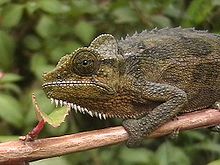- Trioceros hoehnelii
-
Trioceros hoehnelli 
Conservation status Scientific classification Kingdom: Animalia Phylum: Chordata Class: Reptilia Order: Squamata Suborder: Lacertilia Family: Chamaeleonidae Genus: Trioceros Species: hoehnelii Binomial name Trioceros hoehnelii
(Steindachner, 1891)Trioceros hoehnelli, commonly known as Von Hohnel's Chameleon, the Helmeted or High-casqued Chameleon, is a species of chameleon found in eastern Africa, primarily Uganda and Kenya.
Identification
Trioceros hoehnelli is a small to medium size chameleon, growing up to 10 inches in total length. Coloration is highly variable across their range. During morning hours, this chameleon may be seen basking in the sunlight almost completely black in color in order to capture heat energy from the sunlight. This species has a single horn on the rostrum, a serrated back crest, and a spiny throat crest.[1] Males are typically larger than females with a larger casque, horn and enlarged tail base.
Behavior
Most chameleons in east Africa tend to be territorial and the High-casqued Chameleon is no different. If males are placed together, they will hiss at each other, turn black, and compress their bodies to make them look larger. Dominant males display brightly colored patterns that differ from females or subordinate males, which often persist until they are defeated during a courtship battle.[2]
T. hoehnelli forms stable pair-bonds during mating season, which endure throughout the five months of pregnancy. After giving birth, the pair usually splits up.[3]
The High-casqued Chameleon enjoys eating most small insects and spiders and does so by extending the tongue to capture the insect. They are capable of extending the tongue more than a complete body length.
References
- ^ Bartlett, Richard D. (2005), Chameleons: everything about purchase, care, nutrition, and breeding, Barron's Educational Series, pp. 73, ISBN 0764128639, http://books.google.com/books?id=pf8i0quoBgUC&pg=PA72&lpg=PA72
- ^ Gans, Carl (1992), Biology of the reptilia, University of Chicago Press, pp. 350–351, ISBN 0226281248, http://books.google.com/books?id=zaKXzaBVpisC&pg=PA351
- ^ A. G. Toxopeus, J. P. Kruijt, D. Hillenius (1988-05-01), "Pair-bonding in Chameleons", Naturwissenschaften (5), doi:10.1007/BF00378024, http://www.springerlink.com/content/n3687381218l34u4/
Categories:- IUCN Red List least concern species
- Chameleons
- Reptiles of Africa
Wikimedia Foundation. 2010.


